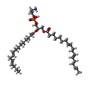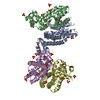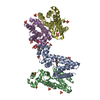+ データを開く
データを開く
- 基本情報
基本情報
| 登録情報 | データベース: PDB / ID: 4umm | ||||||
|---|---|---|---|---|---|---|---|
| タイトル | The Cryo-EM structure of the palindromic DNA-bound USP-EcR nuclear receptor reveals an asymmetric organization with allosteric domain positioning | ||||||
 要素 要素 |
| ||||||
 キーワード キーワード | NUCLEAR RECEPTOR / TRANSCRIPTION / ECDYSONE / USP-ECR / DNA RESPONSE ELEMENT / ALLOSTERY / CRYO ELECTRON MICROSCOPY | ||||||
| 機能・相同性 |  機能・相同性情報 機能・相同性情報ecdysone binding / ecdysone receptor signaling pathway / nuclear steroid receptor activity / RNA polymerase II transcription regulator complex / nuclear receptor activity / cell differentiation / RNA polymerase II cis-regulatory region sequence-specific DNA binding / negative regulation of transcription by RNA polymerase II / positive regulation of transcription by RNA polymerase II / DNA binding ...ecdysone binding / ecdysone receptor signaling pathway / nuclear steroid receptor activity / RNA polymerase II transcription regulator complex / nuclear receptor activity / cell differentiation / RNA polymerase II cis-regulatory region sequence-specific DNA binding / negative regulation of transcription by RNA polymerase II / positive regulation of transcription by RNA polymerase II / DNA binding / zinc ion binding / nucleus 類似検索 - 分子機能 | ||||||
| 生物種 |  HELIOTHIS VIRESCENS (蝶・蛾) HELIOTHIS VIRESCENS (蝶・蛾)SYNTHETIC CONSTRUCT (人工物) | ||||||
| 手法 | 電子顕微鏡法 / 単粒子再構成法 / クライオ電子顕微鏡法 / 解像度: 11.6 Å | ||||||
 データ登録者 データ登録者 | Maletta, M. / Orlov, I. / Moras, D. / Billas, I.M.L. / Klaholz, B.P. | ||||||
 引用 引用 |  ジャーナル: Nat Commun / 年: 2014 ジャーナル: Nat Commun / 年: 2014タイトル: The palindromic DNA-bound USP/EcR nuclear receptor adopts an asymmetric organization with allosteric domain positioning. 著者: Massimiliano Maletta / Igor Orlov / Pierre Roblin / Yannick Beck / Dino Moras / Isabelle M L Billas / Bruno P Klaholz /  要旨: Nuclear receptors (NRs) regulate gene expression through DNA- and ligand-binding and thus represent crucial therapeutic targets. The ultraspiracle protein/ecdysone receptor (USP/EcR) complex binds to ...Nuclear receptors (NRs) regulate gene expression through DNA- and ligand-binding and thus represent crucial therapeutic targets. The ultraspiracle protein/ecdysone receptor (USP/EcR) complex binds to half-sites with a one base pair spaced inverted repeat (IR1), a palindromic DNA response element (RE) reminiscent of IRs observed for vertebrate steroid hormone receptors. Here we present the cryo electron microscopy structure of the USP/EcR complex bound to an IR1 RE which provides the first description of a full IR-bound NR complex. The structure reveals that even though the DNA is almost symmetric, the complex adopts a highly asymmetric architecture in which the ligand-binding domains (LBDs) are positioned 5' off-centred. Additional interactions of the USP LBD with the 5'-flanking sequence trigger transcription activity as monitored by transfection assays. The comparison with DR-bound NR complexes suggests that DNA is the major allosteric driver in inversely positioning the LBDs, which serve as the main binding-site for transcriptional regulators. | ||||||
| 履歴 |
|
- 構造の表示
構造の表示
| ムービー |
 ムービービューア ムービービューア |
|---|---|
| 構造ビューア | 分子:  Molmil Molmil Jmol/JSmol Jmol/JSmol |
- ダウンロードとリンク
ダウンロードとリンク
- ダウンロード
ダウンロード
| PDBx/mmCIF形式 |  4umm.cif.gz 4umm.cif.gz | 168.2 KB | 表示 |  PDBx/mmCIF形式 PDBx/mmCIF形式 |
|---|---|---|---|---|
| PDB形式 |  pdb4umm.ent.gz pdb4umm.ent.gz | 123.3 KB | 表示 |  PDB形式 PDB形式 |
| PDBx/mmJSON形式 |  4umm.json.gz 4umm.json.gz | ツリー表示 |  PDBx/mmJSON形式 PDBx/mmJSON形式 | |
| その他 |  その他のダウンロード その他のダウンロード |
-検証レポート
| 文書・要旨 |  4umm_validation.pdf.gz 4umm_validation.pdf.gz | 833 KB | 表示 |  wwPDB検証レポート wwPDB検証レポート |
|---|---|---|---|---|
| 文書・詳細版 |  4umm_full_validation.pdf.gz 4umm_full_validation.pdf.gz | 869.4 KB | 表示 | |
| XML形式データ |  4umm_validation.xml.gz 4umm_validation.xml.gz | 29.6 KB | 表示 | |
| CIF形式データ |  4umm_validation.cif.gz 4umm_validation.cif.gz | 42.7 KB | 表示 | |
| アーカイブディレクトリ |  https://data.pdbj.org/pub/pdb/validation_reports/um/4umm https://data.pdbj.org/pub/pdb/validation_reports/um/4umm ftp://data.pdbj.org/pub/pdb/validation_reports/um/4umm ftp://data.pdbj.org/pub/pdb/validation_reports/um/4umm | HTTPS FTP |
-関連構造データ
- リンク
リンク
- 集合体
集合体
| 登録構造単位 | 
|
|---|---|
| 1 |
|
- 要素
要素
-タンパク質 , 4種, 4分子 AEFG
| #1: タンパク質 | 分子量: 9256.789 Da / 分子数: 1 / 由来タイプ: 組換発現 / 由来: (組換発現)  HELIOTHIS VIRESCENS (蝶・蛾) / 器官: NUCLEOUS / 発現宿主: HELIOTHIS VIRESCENS (蝶・蛾) / 器官: NUCLEOUS / 発現宿主:  |
|---|---|
| #4: タンパク質 | 分子量: 10099.977 Da / 分子数: 1 / 由来タイプ: 組換発現 / 由来: (組換発現)  HELIOTHIS VIRESCENS (蝶・蛾) / 器官: NUCLEOUS / 発現宿主: HELIOTHIS VIRESCENS (蝶・蛾) / 器官: NUCLEOUS / 発現宿主:  |
| #5: タンパク質 | 分子量: 29962.717 Da / 分子数: 1 / 由来タイプ: 組換発現 / 由来: (組換発現)  HELIOTHIS VIRESCENS (蝶・蛾) / 器官: NUCLEOUS / 発現宿主: HELIOTHIS VIRESCENS (蝶・蛾) / 器官: NUCLEOUS / 発現宿主:  |
| #6: タンパク質 | 分子量: 30368.961 Da / 分子数: 1 / 由来タイプ: 組換発現 / 由来: (組換発現)  HELIOTHIS VIRESCENS (蝶・蛾) / 器官: NUCLEOUS / 発現宿主: HELIOTHIS VIRESCENS (蝶・蛾) / 器官: NUCLEOUS / 発現宿主:  |
-DNA鎖 , 2種, 2分子 CD
| #2: DNA鎖 | 分子量: 6148.989 Da / 分子数: 1 / 由来タイプ: 合成 / 由来: (合成) SYNTHETIC CONSTRUCT (人工物) |
|---|---|
| #3: DNA鎖 | 分子量: 6117.979 Da / 分子数: 1 / 由来タイプ: 合成 / 由来: (合成) SYNTHETIC CONSTRUCT (人工物) |
-非ポリマー , 3種, 10分子 




| #7: 化合物 | ChemComp-EPH / |
|---|---|
| #8: 化合物 | ChemComp-P1A / |
| #9: 水 | ChemComp-HOH / |
-実験情報
-実験
| 実験 | 手法: 電子顕微鏡法 |
|---|---|
| EM実験 | 試料の集合状態: PARTICLE / 3次元再構成法: 単粒子再構成法 |
- 試料調製
試料調製
| 構成要素 | 名称: BRUNO P. KLAHOLZ / タイプ: COMPLEX |
|---|---|
| 緩衝液 | 名称: 10 MM TRIS PH 7.5, 100 MM NACL, 10 MM MGCL2, 10 MM TCEP pH: 7.5 詳細: 10 MM TRIS PH 7.5, 100 MM NACL, 10 MM MGCL2, 10 MM TCEP |
| 試料 | 濃度: 0.1 mg/ml / 包埋: NO / シャドウイング: NO / 染色: NO / 凍結: YES |
| 試料支持 | 詳細: CARBON |
| 急速凍結 | 装置: FEI VITROBOT MARK IV / 凍結剤: ETHANE 詳細: VITRIFICATION 1 -- CRYOGEN- ETHANE, HUMIDITY- 90, TEMPERATURE- 120, INSTRUMENT- FEI VITROBOT MARK IV, METHOD- 2 SECONDS, FORCE 4, |
- 電子顕微鏡撮影
電子顕微鏡撮影
| 実験機器 |  モデル: Tecnai F30 / 画像提供: FEI Company |
|---|---|
| 顕微鏡 | モデル: FEI TECNAI F30 / 日付: 2009年11月20日 |
| 電子銃 | 電子線源:  FIELD EMISSION GUN / 加速電圧: 100 kV / 照射モード: FLOOD BEAM FIELD EMISSION GUN / 加速電圧: 100 kV / 照射モード: FLOOD BEAM |
| 電子レンズ | モード: BRIGHT FIELD / 倍率(公称値): 59000 X / 倍率(補正後): 64244 X / 最大 デフォーカス(公称値): 3000 nm / 最小 デフォーカス(公称値): 1500 nm / Cs: 2 mm |
| 撮影 | 電子線照射量: 20 e/Å2 / フィルム・検出器のモデル: FEI EAGLE (4k x 4k) |
| 画像スキャン | デジタル画像の数: 600 |
- 解析
解析
| EMソフトウェア | 名称: IMAGIC / バージョン: 5 / カテゴリ: 3次元再構成 | ||||||||||||
|---|---|---|---|---|---|---|---|---|---|---|---|---|---|
| CTF補正 | 詳細: CCD IMAGES 4096X4096 | ||||||||||||
| 対称性 | 点対称性: C1 (非対称) | ||||||||||||
| 3次元再構成 | 手法: CROSS-COMMON LINES / 解像度: 11.6 Å / 粒子像の数: 50000 詳細: SUBMISSION BASED ON EXPERIMENTAL DATA FROM EMDB EMD -2631. (DEPOSITION ID: 12447). 対称性のタイプ: POINT | ||||||||||||
| 原子モデル構築 | プロトコル: RIGID BODY FIT / 空間: REAL / 詳細: METHOD--RIGID BODY | ||||||||||||
| 原子モデル構築 | PDB-ID: 1R1K Accession code: 1R1K / Source name: PDB / タイプ: experimental model | ||||||||||||
| 精密化 | 最高解像度: 11.6 Å | ||||||||||||
| 精密化ステップ | サイクル: LAST / 最高解像度: 11.6 Å
|
 ムービー
ムービー コントローラー
コントローラー













 PDBj
PDBj










































